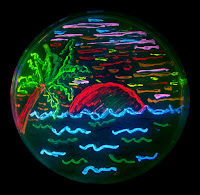Week 6 - BioTech + Art
Week 6 - BioTech + Art
 |
| Microbial art using bacterial strains containing different kinds of fluorescent proteins from the laboratory of Nobel-prize winning biochemist Roger Tsien |
Bioart, roughly defined as the practice in which artists use
biotechnology to create their work, provides a fascinating bridge between the
two cultures of art and science (Pasko). With technologies allowing us to
easily modify and control living organisms becoming more accessible, bioart
provides provocative and stimulating pieces that raise important questions into
the role bioengineering has in society and its foundational ethical principles.
Edurado Kac, a Brazilian-American artist who coined the phrase ‘bioart’,
is famously remembered for his project GFP Bunny. On April 29th,
2000, Kac first held Alba in his arms. Alba was a genetically modified fluorescent
rabbit produced by Kac in collaboration with French geneticist Louis-Marie Houbdebine.
The rabbit was modified through the zygote microinjection of the GFP gene found
in jellyfish that fluoresces green when exposed to blue light. Following Kac’s public
sharing of his project, he was castigated by animal rights groups and members
of the global media for his work.
 |
| Alba, the fluorescent bunny |
Kac’s work raises some very interesting inquiries into the ethics of
transgenic animals. One of these that I personally find fascinating is the
difference in reaction to the use of transgenic animals for medical or
scientific research and the use of transgenic animals for artistic purposes – that
is to say, is it acceptable to modify animals for the advancement of human
health as well as for human aesthetic appeal? Moreover, Kac labels his artwork
as a “Transgenic Art” and not a breeding project. In doing so, he raises
another important question: what are the differences between selectively breeding
plants and animals for aesthetic traits and modifying their genes?
More recently, stem cell research has advanced to a point
where human organs can now be cultured and grown. Amy Karle, a bioartist and one
of the “Most Influential Women in 3D Printing” (All3DP), 3D printed a scaffold
in the shape of a human hand within a biodegradable pegda hydrogel in the hopes
that Mesenchymal human stem cells seeded onto the design would eventually grow
into tissue and mineralize into bone along the scaffold. Although her project, Regenerative Reliquary, pushes
the boundaries of modern stem cell research, it also raises some crucial ethical
and philosophical questions about the use of stem cells. Is it acceptable to swap
our organs with designer organs? Should we be required to have regular organ
replacements to elongate our lives? Should we be allowed to have more than four
limbs?
 |
| Amy Karle's Regenerative Reliquary |
Sources:
- - “40 Most Influential Women
in 3D Printing.” All3DP, 13 Sept. 2017, https://all3dp.com/1/40-influential-women-3d-printing/.
- - Karle, Amy. “Regenerative
Reliquary.” Amy Karle, 2016, https://www.amykarle.com/project/regenerative-reliquary/.
- - Pangburn, DJ. “This Artist
Is Biohacking The Body To 3D-Print Fantastical Human Bones.” Fast Company,
6 July 2016, https://www.fastcompany.com/3060592/this-artist-is-biohacking-the-body-to-3-d-print-fantastical-human-bones.
- - Pasko, Jessica M. “Bio-Artists
Bridge Gap between Arts, Sciences.” Msnbc.Com, 4 Mar. 2007, http://www.nbcnews.com/id/17387568/ns/technology_and_science-science/t/bio-artists-bridge-gap-between-arts-sciences/.
Images:


Comments
Post a Comment